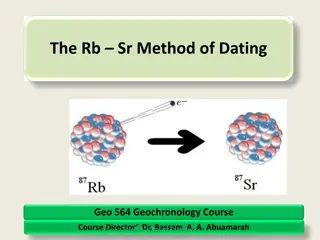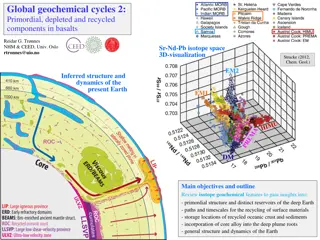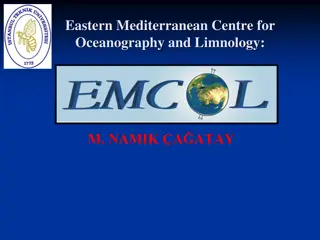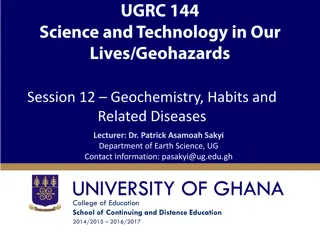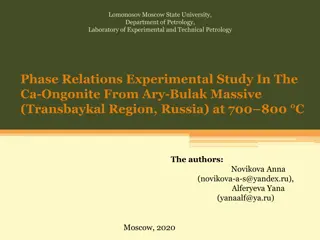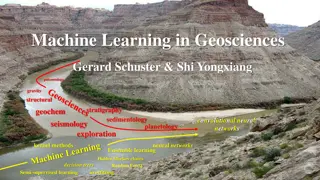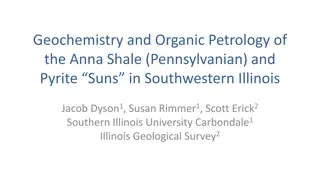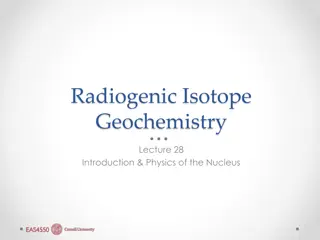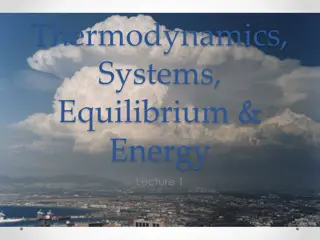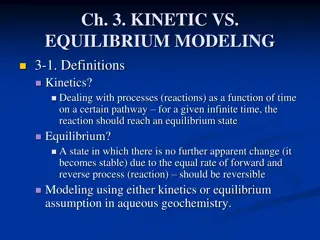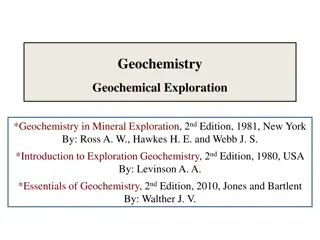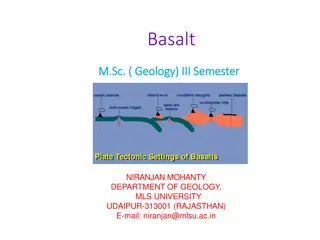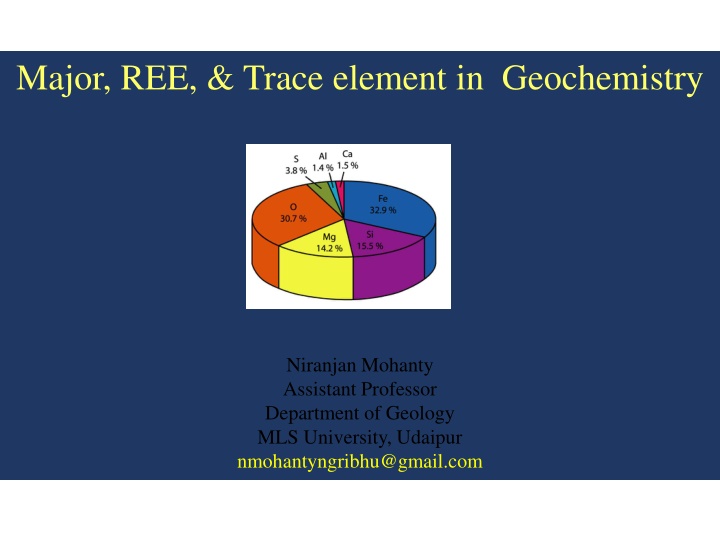
Geochemistry Insights: Major, REE, Trace Elements & Their Significance
Explore the world of geochemistry with a focus on major, Rare Earth Elements (REE), and trace elements. Understand how trace elements are more sensitive to igneous processes and how V.M. Goldschmidt's classification sheds light on element behavior in magmatic systems.
Download Presentation

Please find below an Image/Link to download the presentation.
The content on the website is provided AS IS for your information and personal use only. It may not be sold, licensed, or shared on other websites without obtaining consent from the author. If you encounter any issues during the download, it is possible that the publisher has removed the file from their server.
You are allowed to download the files provided on this website for personal or commercial use, subject to the condition that they are used lawfully. All files are the property of their respective owners.
The content on the website is provided AS IS for your information and personal use only. It may not be sold, licensed, or shared on other websites without obtaining consent from the author.
E N D
Presentation Transcript
Major, REE, & Trace element in Geochemistry Niranjan Mohanty Assistant Professor Department of Geology MLS University, Udaipur nmohantyngribhu@gmail.com
Trace elements & igneous processes Because different minerals selectively incorporate or exclude trace elements with much greater selectivity than for major elements TRACE ELEMENTS are far more SENSITITIVE TO igneous fractionation processes. Origin and evolution of magmas can be better constrained by using trace elements than by major elements.
Goldschmidt V.M.Goldschmidt FATHER OF GEOCHEMISTRY International Goldschmidt conferences are held every two years. He has classfied trace elements and also gave certain rules which predict their behaviour in magmatic systems
Classification of elements in periodic table by Goldschmidt In the classification scheme of Goldschmidt, elements are divided according to how they partition between coexisting silicate liquid, sulfide liquid, metallic liquid, and gas phase Melting a chondrite gives 3 immiscible liquids plus vapor: Atmophile Gas Phase H, He, N, Noble gases Alkalis, Alkaline Earths, Halogens, B, O, Al, Si, Sc, Ti, V, Cr, Mn, Y, Zr, Nb, Lanthanides, Hf, Ta, Th, U Lithophile Silicate Liquid Sulfide Liquid Cu, Zn, Ga, Ag, Cd, In, Hg, Tl, As, S, Sb, Se, Pb, Bi, Te Chalcophile Metallic Liquid Siderophile Fe, Co, Ni, Ru, Rh, Pd, Os, Ir, Pt, Mo, Re, Au, C, P, Ge, Sn Some elements show affinity for more than one group because distribution of an element is also dependent on temp, pressure and chemical environment of system as a whole. For eg Fe, Co, Ni = Siderophile but also chalcophile & lithophile in earth s crust.
Goldschmidt categories are well-grouped in the periodic table of the elements IIIA IVA Atmophile VA VIA VIIA VIIIA Siderophile IA IIA 1 2 H He 1 Lithophile Artificial 3 4 5 6 8 10 7 9 Li Be B C N O F Ne 18 2 Chalcophile 11 12 13 14 16 15 17 Na Mg Al Si P S Cl Ar 36 VIIIB 3 IIIB 21 IVB 22 IB IIB 30 VB 23 VIB VIIB 24 20 25 26 27 28 29 31 32 34 19 33 35 K Ca Sc Ti V Cr Mn Fe Co Ni Cu Zn Ga Ge As Se Br Kr 4 40 44 45 47 48 37 38 39 41 42 43 46 49 50 51 52 53 54 Rb Sr Y Zr Nb Mo Tc Ru Rh Pd Ag Cd In Sn Sb Te I Xe 5 72 73 74 75 76 77 78 79 80 82 55 56 81 83 84 85 86 Cs Ba Hf Ta W Re Os Ir Pt Au Hg Tl Pb Bi Po At Rn 6 87 88 108 109 104 105 106 107 Fr Ra Rf Db Sg Bh Hs Mt 7 57 61 62 64 65 58 59 60 63 66 67 68 69 70 71 La Ce Pr Nd Pm Sm Eu Gd Tb Dy Ho Er Tm Yb Lu Lanthanides 89 90 91 92 93 94 95 96 97 98 99 101 103 100 102 Ac Th Pa U Np Pu Am Cm Bk Cf Es Fm Md No Lr Actinides
Goldschmidt rules trace element distribution 1. When a minor element has same charge & ionic radius as a major element then this substitution is called CAMOFLAUGE e.g. Rb in K (K-feldspars), Ni in Mg in (olivine). 2. When a minor element has similar ionic radius but a higher charge than that of a major element then it is said to be CAPTURED by lattice of major element e.g. Ba+2 in K+ 3. When a minor element has same or similar ionic radius but lower charge than a major element then it is said to be ADMITTED into the crystal lattice of the major element. E.g. Li+ in Mg++ It should be remembered that in CAPTURE & ADMITTANCE ions of different charge, balance has to be maintained by concomitant substitution elsewhere in the structure.
Henrys Law In particular the behavior of the trace element does not depend on its own concentration Depends on - Composition of minerals substituted element (ionic radii, charge etc) Temperature Pressure
Compatible & Incompatible trace elements When Earth s mantle is melted, trace elements display a preference either for a melt phase or a solid (mineral) phase. Trace elements whose preference is for mineral phase are COMPATIBLE trace elements. Those elements which show preference for melt are called INCOMPATIBLE trace elements. Incompatible elements (are not compatible in mineral structure) and will leave at FIRST opportunity. Incompatible elements are also called HYGROMAGMATOPHILE elements.
Illustration of compatibility & incompatibility The degree of compatibility & incompatibility of trace elements vary in melts of different composition. Phosphorous is incompatible element in mantle mineralogy & during partial melting gets quickly concentrated in melt. Phosphorous is compatible in crustal rock like granite since it is accomodated in apatite. Incompatible trace elements are of two types based on ratio of valency to ionic radius: High Field Strength Elements (HFSE) these are smaller but highly charged e.g. REE, Th, U, Zr, Hf, Ti etc Large Ion Lithophile Elements (LILE) or Low field strength elements these are larger but has less charge e.g. K, Rb, cs, Ba, Pb etc LILE are more MOBILE compared to HFSE (Indices of alteration, metamorphism)
Partition coefficient or Distribution coefficient - 1 It is assumed that at equilibrium, the ratio of concentration of a trace element in a solid phase (Cs) to its concentration in liquid (CL) is a constant (D): D= Cs/CL The constant is called PARTITION COEFFICIENT or DISTRIBUTION COEFFICIENT or NERNST PARTITION COEFFICIENT. It is also denoted as KD Eg: Silicate melt 500 ppm of Sr in a plagioclase phenocryst 125 ppm of Sr in glassy matrix KD of Sr for that melt is 4
Partition coefficient or Distribution coefficient - 2 If KD = 1, then trace element is equally distributed between mineral and melt If KD = > 1, then trace element has a preference for mineral phase & in the mineral-melt system under investigation and is a compatible trace element. If KD = < 1, then trace element has a preference for melt phase & in the mineral- melt system under investigation and is a incompatible trace element.
BULK PARTITION COEFFICIENT A rock is an aggregate of minerals, so the Bulk distribution coefficient for a rock for a specific element can be calculated from partition coefficients of constituent minerals weighed according to their proportion. It is defined by expression Di= x1 Kd1 + X2Kd2 + X3K d3 Di = bulk partition coefficient for element I X1 = modal proportion of mineral 1 etc Kd1 = parition coefficient for element i in mineral1 For eg. In a rock containing 50% olivine, 30% Opx & 20% cpx, the bulk partition coefficient would be Di= 0.5 Kold1 + 0.3Kopxd2 + 0.2Kcpxd3
What controls value of partition coefficients in mineral/melt systems? Melt composition (elements partition differently in a acidic or basaltic melt) Temperature (they are a function of temperature) Pressure Oxygen fugacity (activity of oxygen) Water content of melt Crystal chemistry (structure)
Partial Melting application of trace elements Partial melting localization of present day volcanism shows that Earth s mantle melts only partially. It means that required conditions of mantle conditions are available only locally & accessible temperature in earth are not sufficient to melt earth totally! Why earth s mantle melts? The composition of melt depends on (I) mineralogy & chemistry of source (ii) residual mineralogy (iii) depth & degree of melting (iv) type of melting process
Why Earths mantle melts? Rise To Addition of volatiles Lower P
Different types of partial melting based on observations on trace element compositions of basalts Four types of partial melting processes are known: Batch melting or Equilibrium melting or equilibrium fusion melting after a certain fraction of melting , the melt is extracted mechanically from the solid phases in a single batch .Chemical equlibrium is achieved between solid and melt and bulk composition of system remains unchanged until melting is completed). Fractional melting or Rayleigh melting here small melt fractions are continuously & completely extracted as the melting proceeds. Only the last drop of liquid is thought to be in equilibrium with the residue. Continuous melting or disequilibrium melting intermediate process between batch & fractional melting where instantaneous melt is continuously but not completely removed as melting proceeds. Here, a part of melt always remains in residue. Dynamic partial melting a composition of melts produced by both batch melting and continuous melting of a chemically homogeneous source. They show both LREE enriched and LREE depleted patterns with crossing REE patterns.
Trace elements- igneous petrogenesis Use as a petrogenetic indicator Element Ni, Co, Cr Highly compatible elements in olivine, spinel and cpx; High concentrations indicate a mantle source; limited fractionation. Compatible elements; Show parallel behaviour in melting & crystallization;They are useful indicators of fractionation of Fe-Ti oxides (ilmenite or ti-magnetite).If they show divergent behaviour, then Ti substitution into rutile or spheneis indicated. Classic incompatible elements; do not substitute into any major silicate phase; high contents enriched source V, Ti Zr, Hf Ba, Rb Incompatible elements; substitutes for K in KF, Biotite and Hbl; K/Ba or K/Rb indicate role of these phases in petrogenesis. Substitutes for Ca in plagioclase (not in pyroxene) and rarely K in KF; behaves as compatible element at low pressure (where plagioclase forms early) but as incompatible element at high pressures (Plg is unstable). Incompatible elements; myriad used in petrogenesis; HREE >LREE occur in garnet; LREE>HREE in sphene and plagioclase; Eu +2 is strongly partitioned in plagioclase Sr REE, Y
Rare Earth Elements increasing incompatibility
Spidergrams or Spider-diagrams increasing incompatibility

